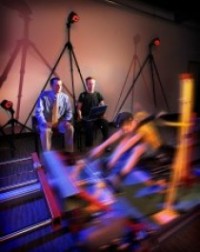Bumper cars may lead to automotive safety for children
Bumper cars may lead to automotive safety for children

What seems like a small amusement park in Rowan University's Education Hall is actually a serious attempt to make cars safer for children.
Rowan University and the Children's Hospital of Philadelphia (CHOP) are partnering to create a pneumatic sled that simulates frontal vehicular collisions.
Terry Hopely, a mechanical engineering graduate student from Pennsville, and Dr. Eric Constans of Pitman, chairman of the Mechanical Engineering program, are finding ways to improve a crash test dummy to better represent a child's physiology.
"Adult crash test dummies pretty accurately model how adults react in a crash," Constans said. "Child crash test dummies are just scaled-down versions of adult models."
The problem, according to Hopely and Constans, is that children are more flexible than adults, and the data taken from traditional child-size crash test dummies, which are the same as adult models but smaller, are simply not accurate. "If you ever play with a child, you would know that it's almost like they're made of rubber. This flexibility isn't represented in current crash test dummies," Constans said.
In order to test the differences between adults and children in crash scenarios, Rowan engineering students built a 15-foot metal track. A child volunteer is seated in a sled the size of a bumper car and fastened with a car seat belt. Using air pressure, the sled is then fired backward on the track at 3.1 Gs (about three times the force of gravity), or approximately five miles per hour. Using an advanced hydraulic system, Hopely applies the brakes on the sled, simulating what happens in a frontal collision, only on a much gentler-and more fun-scale.
"It's completely safe-about 25 percent less severe than an actual bumper car collision at an amusement park," Hopley said. "The backward motion simulates what would happen in a frontal collision, and by moving the sled backward we get consistent, accurate results."
Biomechanical research engineers from the Center for Injury Research and Prevention, the multi-disciplinary injury prevention research center at CHOP, have been working with Rowan for the past few years on child automotive safety issues. In 2006, Dr. Kristy Arbogast, the principal investigator on the project and the director of engineering for the Center for Injury Research and Prevention, developed the idea for the sled by watching bumper cars while at an amusement park with her children.
"Our initial idea was to study kids in bumper cars at the amusement park with high speed video techniques, but we realized that that wouldn't work," Arbogast said. "We needed to conduct the study where we can control the movement and visualize what's happening during the simulations."
According to Arbogast, the real challenge of designing more realistic child-size crash test dummies in the past had been largely ethical. But this study, she said, is an effective and safe way to develop a better model.
"Traditionally, engineers have modeled crash test dummies using whole body [adult] cadavers to see how bodies move," she said. "Of course, when it comes to kids, such studies are not easily done. Because of that, the auto industry uses pediatric dummies scaled from adult data. So, we began thinking about how we could study kids in a way to give us clues about how they react in a crash. And this project is doing just that."
Hopely, working in collaboration with Arbogast, Dr. Sriram Balasubramanian and Thomas Seacrist from CHOP's injury research center, said working with children has been an education in and of itself. For the past six months, he has been working with children from the ages of six to 15.
"Some of the kids are apprehensive at first," he said. "You have to reassure them that the sled is completely safe-even less severe than what they would experience at the amusement park. And then there are kids who absolutely love it-they're really psyched to go for a ride."
Always under the supervision of their parents, the children need to be prepped before sitting on the sled. They are fastened with multiple luminous "dots"-similar to those used on actors in a computer-generated movie scene-which accurately indicate the body's movement through eight specialized cameras.
To make it easier and more entertaining for the volunteers, cardboard cutouts of the animated characters from the Disney movie Cars have been placed in front of the sled.
"It's really all about making them feel more comfortable," Hopely said.
Hopely added that this project is one of the most important at Rowan, and the impetus for it has always been to save lives.
"This is one of the first studies to use live child subjects in actual impact scenarios," he said. "There have been several studies of the neck and spine under static conditions, but this is really a very novel experiment. The fact that we're improving child safety has to be the biggest reward."